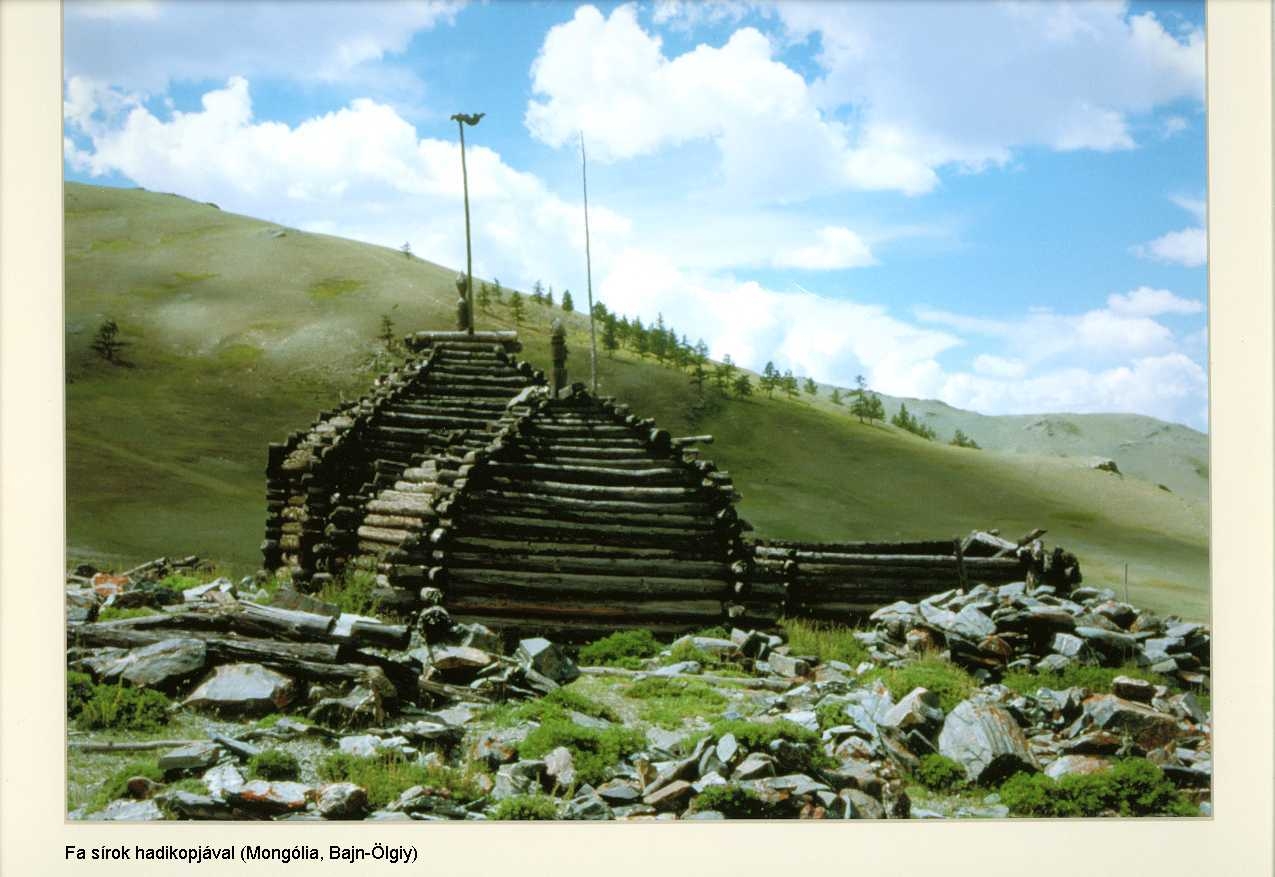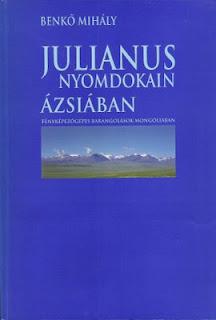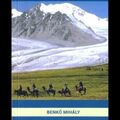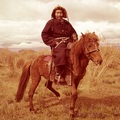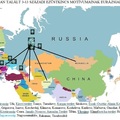Picture: Hungarian graves. Mongolia, Bajn-Ölgly, Foto: Mihaly Benko
The title of Mihály Benkő’s book, facing the reader, refers to the Eastern journey of Julian Dominican friar three other members of the Dominican order. They set out discover the whereabouts of the Eastern Magyars in the spring of 1235. It was Prince Béla, the heir of the Hungarian throne, (Béla IV. Hungarian king from 14 October, 1235) who covered the costs of their journey and he also gave escort to the friars. First they travelled overland into Constantinople, there they embarked on a galley and sailed on the Black Sea to the Taman Peninsula where they disembarked in the port of Matrica (Matarcha). He antecedents of this journey were that a few years earlier, in 1232 an other group of Dominican friars set off in order to meet the Eastern Magyars. They were away for three years, but they couldn’t reach their aim “because of the dangerous roads”. Only one of them, Friar Otto was successful. He travelled as a merchant, and found some Hungarian-speaking people “in a Pagan country”. He got to know from them the whereabouts of the Eastern Magyars. However, instead of visiting them he rather returned into the Hungarian Kingdom. He wished to go back to the East with other friars of his order, to spread the Christian religion among the Eastern Magyars. Alas, only eight days remained from his life. He had just given a report before he died. Julian and the other three friars set off using the information got from his report.
Now we have a look at those historical events which made this journey necessary. Having obtained the rule over all Mongolian tribes in 1206 Genghis Khan conquered the Asian countries one after the other. His campaign against Chwarism took place in 1219. This great Middle Asian empire collapsed under the strikes of the Mongolian army. Muhammad Xvarismsah himself was pursued by the Mongolian vanguard led by the two best army-leaders of Genghis Khan: Subotei and Jebe. He fled to an island of the Caspian Sea, where he died. The Mongolian generals instead of returning to the main army of the Great Khan, continued their reconnaissance raid in East Europe. After ravaging the Transcaucasia they broke through into Ciscaucasia at Derbent, where they defeated the Alans and later also the Eastern Cumanian tribes. The Eastern Cumanians made an alliance with the southern Russian princes then, but the allied Cumanian-Russian army suffered a crushing defeat at the Khalkha River, in the neighbourhood of Mariupol (northward of the Azovian Sea.) from the Mongols. Having heard these disquieting news the Western Cumanian tribes turned to the Hungarian King for protection. In 1227 Bars Cumanian ruling prince bapticized and declared himself and his people to be subjects of the Hungarian Kingdom. The surrendered Cumania got under the reign of Prince Béla (the later King Béla IV.) in 1227. In 1229 the Archbishop of Esztergom established the Cumanian Episcopate, its centre was in Southern Moldavia. This new situation necessitated the extension of the Hungarian intelligence towards the East. The danger of a Mongolian invasion got more and more threatening. At the same time, the influence of the Hungarian Kingdom increased significantly in the East because of the surrendering and bapticizing of the Western Cumanians. So, unexpectedly, an ancient tradition, preserved in the Gesta Hungarorum, got to new life. This tradition told that the Land-Conqueror Hungarians came from Scythia, bordered by the Don /Tanais/ River into the Carpathian Basin. There they converted to Christian religion, but their brothers, staying in the East, remained Pagans. After the surrender of the Western Cumanian tribes the Dnieper-Don river got into the sphere of the Hungarian Kingdom. So, it is understandable that the thought of visiting the Eastern Magyars in Scythia (the Dnieper-Don Region) and bapticizing them arose in the Hungarian royal court, especially because the conversion of the Eastern Magyars would have meant their political integration too, as it was in case of the Western Cumanians.
That’s why Prince Béla, the ruler of Eastern Hungary and the sovereign over the surrendered Cumanians supported the exploratory journey of the Dominican friars in 1232. The organisation of the Dominican Order began in Hungary only in 1221 but the members of this order had already proved that they are ready to endure all possible difficulties and even to give their lives for their objectives. The so-called Riccardus report gives an account of the first journey of Friar Julian. According to this report Friar Otto and his three comrades travelled “overland and on sea, going through a great deal”. We can conclude that the Julian and his company began their journey following the instructions of Friar Otto, so the initial route of the two journeys was about the same. There were two reasons, why they selected to sail to the northern coast of the Azovian Sea. Firstly, they were looking for the Eastern Magyars in the Scythia of the medieval geographic world concept. Secondly, the roads were dangerous on the East European steppes after the Battle at the Khalkha River. It was more secure to sail to the Taman Peninsula.
The last determined point of localisation of the Riccardus’s report about the journey of Friar Julian was the port of Matrica. So, we may conclude that the information got from Friar Otto about the location of the Eastern Magyars had to be uncertain, dim and quite unreliable. We can’t be surprised at this fact. How could have been marked a punctual route on a roadless steppe, extending to several hundred thousand miles without maps, compass, or any fix points of orientation? Julian and his co-travellers did not know, how to continue their journey from Matrica. At the end their host, a princess helped them. “They crossed a lowland plain without people and houses in thirteen days’ time. Then they arrived to the land named Alania”.
The science of history gave much thoughts to the problem: which was the place where Friar Julian and his comrades arrived from Matrica, and where they tried to find the Eastern Magyars? The descendants of the Alans are the Ossetes, whose country and its centre, Dzauidzaku lays northward of Georgia, in the Caucasus. So, according to a widely spread historical conception, Friar Julian endeavoured to find a people, named sevordi in Armenian, siyavardija in Persian language, which was living South of the Caucasian Mountains. Some researchers argue that they were the Hungarians who remained in the East before the Land Conquest. The source of this conception is the work of Constantine VII Porphyrogenitus: “The ruling of the Empire”, The Byzantine Emperor tells that when the Hungarians were in contact with the Khazars they were named Sabartoi asphaloi (plural in Greek) and the Eastern Magyars, separated from the bulk of the Hungarian tribes by the Pechenegs preserved this name. The researchers of the history of the ancient Hungarians identified the Magyars, named Sabartoi asphaloi with the sevordi-s of the Armenian chronicles and the siyavardiya of the Arabian sources. However, this conception is mistaken and unwarrantable. The sevordi-s or siyavardiya-s were the descendants of those Sabirs who were settled by the Byzantines at the Kura River in 574 A. D. As the events described by Constantine Porphyrogenetus took place in the last third of the IX. Century A. D., we can conclude that neither the sevordi-s nor the siyavardiya were Hungarians. So, Friar Julian had no reason to look for the Eastern Hungarians in Transcaucasia, especially because there are no references of their being there in the Hungarian historical tradition either. The source of this idea was an improper translation of the above mentioned report of Constantine Porphyrogenetus. According to this translation the Byzantine Emperor stated: “One part of them settled down Eastward, near to Persia”. However, the proper translation of this sentence is the following: “One part of then lived in the East, towards Persia”. So, Persia appeared as representative of the eastern direction in the text, because for the Byzantine Empire East and Persia was the same notion. By the way, the real living place of the sevordi-s did not belong to the Persian Empire at all. The Hungarians, separated by the Pechenegs could remain only in the Volga Region.
We can draw the conclusions that Friar Julian couldn’t hope to find the Eastern Magyars in Trancaucasia. The Riccardus report doesn’t tell anything like this. True, “Alania” is mentioned in it, but this fact doesn’t mean that the route of Friar Julian touched the territory of Ossetia. The territory ruled by the Alans was quite large in the Middle Ages. For example their fortification, Sarkel controlled the communication across the Don River at the end of the 1st Millennium A. D. The description of Riccardus tells that Friar Julian passed through plains without houses and people. So, we can exclude the possibility that he approached even the foot-hills of the Caucasus. Taking into account the road network of our days which most probably follows the track of the ancient caravan routes we see two possibilities for Friar Julian for the continuation of his journey. One of the roads led Northward to the mouth of the Don River. Had Friar Julian selected this road he would have got to the territory of the Cumanians and not into the Volga Region. The other possibility was for him to direct his way towards the East. Having travelled for thirteen days through the dry steppe region he could have reached into the town Stavropol of our days. From there an important road starts in north-eastern direction through Stepnoj to Caricyn, where it turns northward. This road was certainly the most important long distance caravan route leading from the ports of the Taman Peninsula to the Caucasus Region to the Volga Bulgarians (Magna Bulgaria). It couldn’t happen by chance that Friar Otto travelled on this route in the disguise of a trader.
According to an earlier interpretation of the route of Friar Julian in our historical literature, the original itinerary of the Dominican monks was to visit the Savard-Hungarians in Transcaucasia and they changed their plan only because of the danger of Mongolian raids. Apart from the fact that the Savard-Hungarians did not exist in the Transcaucasia there are no references of a possible modification of Julian’s itinerary in the Riccardus report. It mentions only that “the monks could not find co-travellers (guides) for proceeding (procedendi) because of the fear from the Mongols”. The Mongols mentioned in the report could not be the troops of Cormayan army leader, fighting in Persia, because his troops stationed thousand kilometres southward from the lower riches of the Kura river in those years. However, the headquarters of Genghis Khan’s eldest son, Juci were near to the Ural River that time (and to the Uralsk town of our days). His troops controlled the territory at least to the lower reaches of the Volga River, and he also ruled over those territories of the eastern Cumanian tribes which were conquered by Jebe and Subotei in 1222-1223. The route of Friar Julian went through these territories. So, the “fear from the Mongolians” was not without reason. After all, Friar Julian could recruit a few “Pagan” co-travellers and set off together with Friar Gerhardus, but the two other Dominican monks returned into Hungary. Enduring incredible hardships, they crossed “a plain without roads and tracks” in thirty seven days, and arrived into a town named Bundaz on a Muslim territory. Then they continued their journey up to a town, not named in the report, where Friar Gerhardus died. In thirty seven days’ time Julian could cover about 1100 kilometres distance and could get to the line between two towns of our days, Penza and Kuzneck located on the left bank of the Volga River. But he did not find the Eastern Magyars. He stepped into the service of a mullah and travelled with him into Magna Bulgaria. At the end, he met a Magyar woman there who explained to him, how to get to the Magyars who were living in two days’ distance from them. So, Friar Julian arrived to the Eastern Magyars “at the Large Etil River”. As more then one river was named “Etil” in the Volga-Ural Region, there were many disputes, which river is the “Large Etil” mentioned in the report However. this problem is settled without doubt by the epithet “”large” in the text. The “Large Etil River” can only be the Volga River, because this river was named Uluy Etil (Large Etil) in contrast with the Belaja River, the Aq Etil.
There is a striking common motif of journeys of the two groups of the Dominican friars, marked by the names of Friar Otto and Friar Julian, not noticed by the science of history up to now. Namely, that both groups found the Eastern Magyars by chance. However, important conclusions can be drawn from this fact. First of all, the political organisation of the Eastern Magyars was not independent on such a degree that that people living around the main caravan-routes or in the towns of East Europe would have known about them as about “Magyar” or Madzhar” ethnical entity . Both Otto and Julian found them incidentally: they met such persons who spoke Hungarian and so they could identify them as Magyars. Indeed, when Julian reached the Magyars of the Volga Region, he could give account only about their houses and about the settlements of their clans (villa) Obviously, the Eastern Magyars lived in the frames of the political organisation of the Volga Bulgarians and they could be found and identified only on the basis of their Magyar language.
At the time when Friar Julian met the Volga Magyars they were already living in Mongolian political and military organisation. As the Riccardus report tells: The Tartars … suffered defeat in their first battle. (against the Volga Bulgarians) For this reason they recruited them (namely the Volga Magyars) as friends and comrades” The report tells about the events of the year 1223 here when the Mongolian vanguard having defeated the Eastern Cumanians, on the way back to the Ural River invaded the Volga Bulgarians and suffered defeat. Then, using their usual dividing tactics, the Mongols induced the Eastern Magyars to form an alliance with them. The Volga Magyars joined the Mongolian military and political organisation and this fact determined their further fate. The Volga Magyars belonged to that part of the empire (ulus) where the ruler was Genghis khan’s eldest son, Djuci, followed by his son, Batu. A few decades later a complicated reorganisation of the Mongolian army and its allied troops took place in the course of the war for the complete conquest of China and of the feud between the four branches of the family of Great Khan. For example even European Alan troops got into the élite body-guard troops of the Great Khan that time. The Volga Magyars were also dispersed in the Mongolian Empire. One part of them remained in the ulus and army of Batu Khan (the so-called Golden Horde). The relics of these Magyars are the Mad’yar place-names and clan-names in Western Kazakistan. An other significant group of them got into the ulus of Cayatai. The Madzar clan, having appeared in the army of Seibani Üzbek khan who conquered Transoxania; the Üzbek people-group, named Madzar living between Bukhara and Samarkand,; and also the Madzar clan living among the Khivan Üzbeks were and are their descendants.
Now, when we try to value the exploratory expedition of Mihály Benkő led into the Mongolian Altai to the Mazsars and to compare it with the journey of his foregoer, Julian (meantime considering the historical fate of the Volga Magyars remaining in the east), a common feature of these endeavours may immediately strike into our eyes. It is extremely difficult to find the Eastern Magyars. Practically it can happen only by chance. In the age of Friar Julian the fact that they preserved the Hungarian mother tongue made their identification somewhat easier, but our former common language had already disappeared among them. Mihály Benkő made photos of the Mazsars of the Mongolian Altai without knowing whom they are in the course of one of his earlier expedition. He needed long years to win their friendship and trust on such an extent that they uncovered themselves before him. Namely for this reason we cannot overvalue the fact that they could preserve their traditions, the relics of their ancient culture, their identity consciousness. Also, we cannot overvalue the fact that Mihály Benkő succeeded in finding them, recording their ancient genealogical legends, making photos of the relics of their ancient culture which bring our Land-Conqueror ancestors to new life.

Picture: Europian faces. Bajn-Ölgly, Mongolia. Foto: Mihaly Benko
Mihály Benkő succeeded in documenting the cultural inheritance of the ancient Hungarians as living tradition of the Altaian Magyars-Mazsars in three important spheres. The most ancient one of these strata is the Legend of the Miraculous Stag which has important role in the traditions of the Land-Conqueror Hungarians too. It is an interesting observation that this legend survived among the Altaian Magyars-Mazsars in a negative reflection: they ceased to follow the Miraculous Stag and returned into Asia. The same negative attitude is reflected in their other genealogical legend which seems have historical background. Maybe their fights in the army of Seibani Khan are preserved in their following tradition: when a great battle took place at the Syr Dar’ya River they were not willing to fight: they hid away. Having done so they lost their face, gave up their original name and from that time they named themselves as “mogd”. A Turkish text from Turfan throws light on the social-psychological roots of this experience. The Türkish “boyd” word, analogy of the Kipchak “moyd” word is put down in the given text: eski atin tegsilip yani boltun boydam atin tegsilip tatyílyí boltun “your old name had changed, you became a new man; your stained name had changed, You became an acceptable man”. This way it gets understandable why they are unwilling to tell their “stained” name to anybody. However, they preserved their ancient culture. Their traditional belts and saddles fitted with palmetto-ornamented silver mounts might have been excavated from the graves of the Land-Conqueror Hungarians. Their horse sacrifices, their burials, the flagged spears on their graves are relics of the life and death of the ancient Magyar mounted warriors. Taking in our hand Mihály Benkő’s photo album the pompous richness of the ancient life of our Land-Conqueror ancestors presents itself to our eyes.
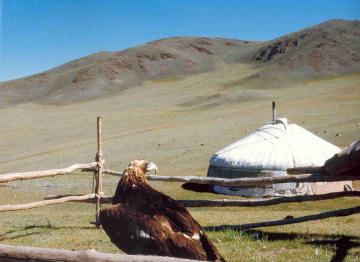
Picture: Hunting eagle. Bajn-Ölgly, Mongolia. Foto: Mihaly Benko

